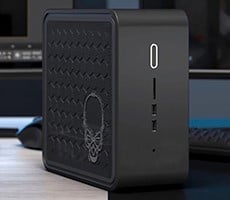Shuttle SN25P XPC (nForce 4 Ultra)
The FN25 motherboard used in the Shuttle SN25P XPC is equipped with an Award / Phoenix v6.0 BIOS derivative, very similar to the vast majority of the other motherboards shipping today. Shuttle has added a few additional tweaking options, however, that give the their XPCs some fairly unique features and capabilities...
|
Like most systems, the majority of the SN25P's standard BIOS menus contain options that are commonly found on a plethora of other products. The Standard CMOS Features, Advanced BIOS Features, and Advanced Chipset Features menus are home to some of the more common options available for enabling or disabling integrated peripherals, assigning the boot order, setting the time and date, etc. The PC Health section is used to monitor temperatures and voltages, as well as tweak the "Smart Fan" settings, which in turn will affect the SN25P's noise levels.
In our first review of a P-Series XPC (the SB81P), we noted that some analysts experienced CPU throttling with high-end Pentium 4s installed, due to the default configuration of the "Smart Fan" options. The SN25P, however, did not appear to suffer from any thermal issues whatsoever in our experience. After running for days with an Athlon 64 4000+, a GeForce 6800 GT, and a 10K RPM hard drive installed, we did not have to contend with any thermal issues at all.
|
In the Frequency / Voltage Control menu is where users will find most of the SN25P's various overclocking options. The advanced chipset menu is home to the rest. Using the options available on the FN25 motherboard, users can alter their processor's bus speed between 200MHz and 300MHz, in 1MHz increments. The CPU and HT multipliers can also be adjusted, and DRAM and chipset voltages are user configurable as well. CPU voltages between 0.8v and 1.7v (in 0.0125v increments) are available, DRAM voltages range from 2.7v to 2.9v (in .1v increments), and chipset voltages between 1.6v and 1.7, in .05v increments, are available. Noticeably absent was an option to manually lock or dial-in specific PCI Express / PCI clock speeds.
Overclocking with the Shuttle SN25P XPC was very easy, as it is with most nForce 4 Ultra based systems. To overclock our processor, we first increased our CPU voltage by .1v, and then raised the chipset and Memory voltages as well, to 1.7 and 2.9v respectively. We then dropped the HT multiplier to 3x (600MHz DDR effective) and dropped our CPU's multiplier as well, and increased the HT clock speed until the system was no longer stable. In the end, we hit an impressive 280MHz HT clock speed. The system would actually boot and load Windows with higher clock speeds, but we couldn't reliably complete all of our benchmarks, so we backed things down a bit. 280MHz seemed to be the sweet spot with our particular setup.
Throughout all of our testing, we kept our trusty RadioShack noise level meter nearby, and recorded the maximum and minimum noise levels emitted from the SN25P. With our meter about 3 feet away from the system, we never registered any thing higher than 48db. And that was when the system was first powered up and the fans were spinning at their maximum speeds. When the "Smart Fan" controls took over, and throttled fan speeds according to system temperatures, the SN25P was barely audible. If you don't plan to overclock your XPC or will be using a mid-range CPU, and want a near-silent system, the SN25P would be a great choice.






